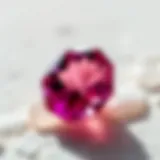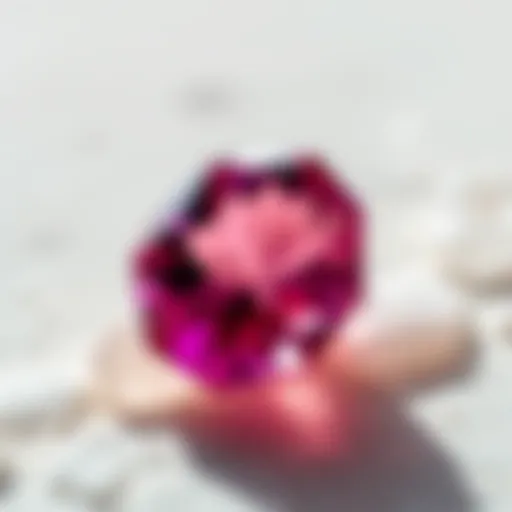Mastering Ring Measurement: A Guide for Enthusiasts
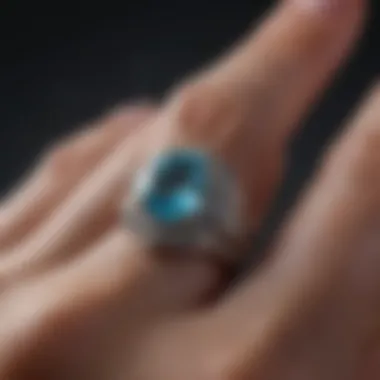

Intro
When it comes to jewelry making and collecting, understanding ring measurement charts is an essential skill for gemstone enthusiasts. The right ring size guarantees not only comfort but also enhances the visual appeal of the gemstones adorning the piece. This guide will delve into the intricate world of ring sizing, ensuring that you comprehend the nuances of measurement, the importance of selecting the appropriate size, and the various methods that can help you achieve optimal results. As we journey through this comprehensive guide, you will find valuable insights that marry practicality with the aesthetics of jewelry design.
Gemstone Overview
In the realm of gemstones, each piece comes with its distinct charm and physical properties. Some gemstones are renowned for their dazzling colors, while others attract attention due to their rarity. Understanding these characteristics can significantly impact your choice of ring size and style.
Description of the Gemstone
For example, consider the elegant sapphire. This gemstone is not just visually striking but also comes in a spectrum of shades, predominantly deep blue. Sapphires are often associated with nobility and wisdom. Choosing a ring design that highlights the gemstone's beauty without overshadowing its brilliance is crucial. Whether it’s an engagement ring or a statement piece, the cut and placement of the sapphire matter greatly.
Physical Properties
Physical properties play a pivotal role in ring measurements. Sapphires measure around 9 on the Mohs hardness scale, which makes them durable, perfect for daily wear. However, different gemstones, such as opal or emerald, may require special consideration due to their relative softness. This knowledge is essential when selecting a setting that protects the stone while complementing its attributes. It’s no use having a stunning gemstone if the weight of the setting compromises its safety.
"Choosing a ring is much like finding a perfect pair of shoes; comfort and style must go hand in hand for a harmonious experience."
Healing Properties
Many gemstones aren't just admired for their physical beauty; they are also revered for their metaphysical properties. Gemstone enthusiasts often inquire about how these attributes affect the wearer's experience.
Metaphysical Attributes
For instance, the calming qualities of amethyst are widely acknowledged. This purple stone is believed to promote tranquility and balance, making it an ideal choice for rings intended to provide comfort during stressful times. The properties of each gemstone can influence the design and size, affecting the wearer's feelings and experiences.
Common Uses in Holistic Practices
Gemstones find a place in holistic practices, where they are often used in meditation or worn as talismans to align energies. A ring featuring a rose quartz may enhance love and self-acceptance, while a black tourmaline offers protective shielding. These selected stones are as much about personal connection as they are about the visual appeal, thereby making the right size vital for effective energy transfer.
Selecting the right ring size works in tandem with understanding the gemstone properties and their potential benefits. This synergy will help gemstone enthusiasts not only wear their jewelry with pride but also engage with the deeper significance each piece holds. As we progress through this guide, we'll explore recommended measuring techniques, the significance of accuracy, and how to navigate the various types of measurement charts available. This journey ensures that every gem integrates seamlessly with its wearer's spirit.
Foreword to Ring Measurement
When it comes to jewelry, the right ring size isn’t just a matter of comfort; it's a crucial aspect that can affect both aesthetics and wearability. Understanding ring measurement might seem straightforward, but there’s a whole world of nuances beneath the surface. For gemstone enthusiasts, knowing the ins and outs of ring sizing can significantly alter their experience, whether it's for personal adornment or for crafting bespoke jewelry pieces.
Accurate ring measurement plays a major role in ensuring that each gemstone is showcased effectively without compromising the structural integrity of the ring itself. Imagine slipping on a beautiful ring, only to have it slide around your finger like it’s doing a dance. Conversely, a ring that fits too snugly may not only be uncomfortable but can also lead to potential damage over time.
The importance of this topic cannot be overstated. Here are a few key points worth considering:
- Personal Experience: A correctly sized ring enhances the wearing experience, making it enjoyable rather than frustrating.
- Aesthetic Appeal: Different gemstones come in various shapes and sizes. Knowing how to measure correctly allows jewelers and hobbyists alike to select the perfect setting to highlight each stone’s unique sparkle.
- Practical Knowledge: This knowledge empowers buyers to make informed decisions when purchasing rings, ensuring they select the right sizes for themselves or gifts.
- Avoiding Costs: Getting the sizing right the first time can save money in the long run by avoiding costly resizing or replacement.
In the sections that follow, we are going to dive deeper into methods for measuring ring sizes, explore different types of measurement charts, and look into considerations when selecting rings for various gemstones. So, let’s embark on this journey into the art of ring measurement and understand how it can elevate both the enjoyment and craftsmanship of jewelry.
The Importance of Accurate Ring Sizing
Accurate ring sizing plays a pivotal role in the world of gemstones and jewelry design. When one commits to the creation or purchase of a ring, the size can impact both practical aspects and the aesthetic experience. A ring that fits like a glove not only feels more comfortable, but also showcases the gem's beauty to its fullest potential. Conversely, an incorrect size can lead to frustrations that sometimes overshadow the joy of owning a striking piece. This section explores the vital reasons for getting the sizing just right, emphasizing its benefits and considerations.
Implications of Incorrect Sizing
Getting the ring size wrong can lead to several significant repercussions. Firstly, a ring that is too tight can cause discomfort, making it difficult to wear for extended periods. Swelling in fingers, which can occur due to various factors such as heat, physical activity, or even dietary habits, may leave the wearer in a bind—literally. The ring might become almost impossible to remove without force, raising the risk of potential injury to both the finger and the ring.
Additionally, there are aesthetic implications. A ring that is too loose can slide around on the finger, often appearing sloppy, which detracts from its overall elegance. Just imagine a gemstone rotating, leaving its facets obscured rather than beautifully displayed. Moreover, if the ring falls off during daily activities, there's a clear risk of losing a treasured piece and with it, perhaps a unique emotional connection.
"Sizing a ring is not merely a measurement; it's an understanding of one's personal and physical comfort. The right size speaks volumes about attention to detail."
Impact on Wearability and Aesthetics
Wearability and aesthetics are two sides of the same coin when it comes to ring sizing. Think of a stunning sapphire ring with intricate detailing—if it doesn't fit properly, it can appear less enchanting. The way a ring rests on a finger influences how light interacts with its curves and surfaces. A snug fit allows the design to be visible in all its grandeur; a loose fit not only hinders this but may also change how the piece is perceived by an onlooker.
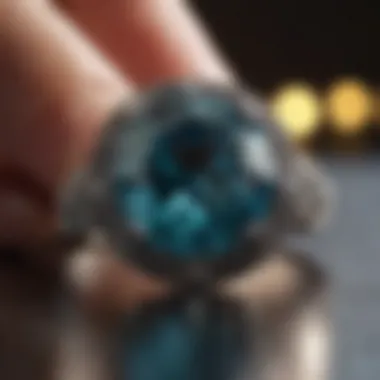

Let's not forget how personal style plays into this aspect. A well-fitted ring can accentuate one's personality through curated choices in stone setting, band style, and overall design. On the contrary, a poorly sized ring can send mixed signals, suggesting a lack of care or thoughtfulness in the selection process. It's essential for gemstone enthusiasts and jewelry designers alike to grasp how precision in sizing guides crucial elements of wearability and charm.
In summary, understanding the importance of accurate ring sizing is fundamental for anyone involved in the necklace industry—be it collectors, enthusiasts, or artisans. The implications of incorrect sizing underscore the need for diligence, while the impact on wearability and aesthetics highlights the value of getting it right. With these considerations in mind, one can navigate the realm of gemstones and create pieces that are not just visually stunning but also personable and comfortable to wear.
Methods for Measuring Ring Sizes
In the world of jewelry, measuring ring sizes accurately is like having a compass in the wilderness. It directs you to the right size, ensuring that the gems you're so passionate about are matched with the perfect fit. Understanding the methods available for measuring ring sizes not only aids in your personal collection but also enhances your skills as a jewelry designer. Each method offers its own set of advantages and considerations, making it essential for enthusiasts to be well-versed in these techniques.
Using a Standard Ring Sizer
A standard ring sizer is often the go-to choice for both casual jewelry enthusiasts and professional jewelers alike. This tool typically resembles a set of rings of various sizes, linked together on a chain or strip. Why opt for a standard ring sizer? Well, it provides an accurate and tangible means of gauging size directly.
- Ease of Use: Simply slide the rings onto your finger until you feel a snug fit.
- Reproducibility: As long as you use the same standard, you can replicate measurements reliably.
- Availability: Most jewelry suppliers stock these for easy purchase or even lend them out for a short time.
However, one caution: ensure to assess your finger's widest part for the most precise reading. This is especially crucial if you have knuckles that are larger than the base of your finger.
Measuring with String or Paper Strips
Using a string or a strip of paper to measure your ring size offers a handy alternative when a ring sizer is out of reach or if you're feeling a bit more resourceful. Here’s how to go about it:
- Cut a strip of paper (or a piece of string): About 10 inches in length should do the trick.
- Wrap it around the base of your finger: Make sure it isn’t too tight or too loose. You need a fit that feels comfortable but still snug.
- Mark the area where the string or paper overlaps: This marks the circumference of your finger.
- Measure the length: Use a ruler to determine the length of the strip.
- Convert to ring size: You can compare this measurement to an online ring size chart or use a conversion table found in various gemstones guides.
This method is especially useful during those times when you are either trying to size yourself or someone else without having the traditional tools on hand. Just keep in mind, this method can be a bit less precise as varying pressure can alter the measurements.
Online Ring Size Conversion Tools
With the digital era in full swing, online ring size conversion tools have gained popularity for their convenience. These tools allow you to convert measurements easily and can be a lifesaver when dealing with different sizing standards from around the world. Here’s why they come in handy:
- Global Compatibility: You can enter a measurement in one standard, like US sizing, and instantly get the equivalent in UK or European sizes.
- User-friendly: Most tools have an intuitive interface, perfect for even those less tech-savvy.
- Immediate results: In just a few clicks, you have the information you need without flipping through pages or calculating manually.
"Accurate measurements make the difference between a ring that sparkles beautifully and one that may need resizing just when it should shine."
Types of Ring Measurement Charts
Ring measurement charts are essential tools in the realm of jewelry, especially for gemstone enthusiasts. They serve as a guide to translate the complex dimensions of different ring sizes into standardized measurements, aiding both buyers and makers. When hunting for a perfect ring, whether it’s for a beloved or for oneself, understanding the variances among various charts becomes paramount. This knowledge ensures that your chosen gem not only fits properly but also aligns with personal preference and style.
Various types of ring measurement charts exist, each tailored to a specific region or measurement system. Familiarity with these charts can streamline the purchasing process, enabling informed choices that save both time and frustration. Let’s dive deeper into the most commonly used ring size charts.
Standard US Ring Size Chart
The Standard US Ring Size Chart is widely adopted across North America and is crucial for those looking to buy or create rings in the United States. This chart assigns a numeric value to each size, typically ranging from size 3 to 13, with half sizes in between. It’s worth noting that sizes can vary slightly between manufacturers, but this chart provides a solid starting point.
Here are some important features of the US Ring Size Chart:
- Numeric Scale: Each ring size is represented by a number.
- Increments: The sizes usually increase in increments of 0.25.
- Measurement Units: Sizes correlate directly with the diameter of the ring in millimeters.
To ensure a perfect fit, it’s advisable to measure at the end of the day when fingers are at their largest. Remember, the right fit goes beyond comfort; it influences the overall aesthetic and wearability of the piece.
European Ring Size Scale
In contrast, the European Ring Size Scale opts for a slightly different approach by using a letter system, combined with a circumference measurement. Each letter corresponds to a specific circumference, making it slightly more comprehensive in some scenarios. The sizes typically range from size 40 to 76, each number representing the inner circumference of the ring in millimeters.
Key points about the European system include:
- Letter Designation: Sizes range from A, B, C, etc.
- Circumference: Each letter is then linked to its measurement in millimeters.
- International Appeal: Useful for those purchasing rings from European retailers.
This scale can be particularly helpful when dealing with custom designs, especially when attempting to match a unique gemstone shape to a fitting that not only complements its beauty but also serves practical wearability.
UK and Commonwealth Size Charts
In the UK and many Commonwealth countries, the ring size chart diverges again, employing an alphabetic system, similar to Europe. The sizes typically follow a scale from A to Z, with subsequent half sizes in between, like A½. This means that the sizing can get more nuanced, providing a more tailored selection for consumers.
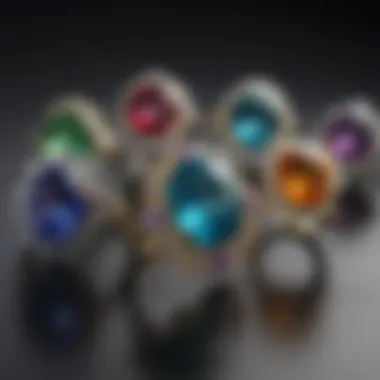

Factors that define this chart include:
- Alphabetic Sizing: Easier for some to follow as it aligns closely with common sizing practices in clothing.
- Half Sizes: Allows for a more precise fit by providing additional options.
- Widely Recognized: Whether you’re in the UK, Australia, or New Zealand, this system retains a strong presence.
Navigating through these charts can feel like searching for a needle in a haystack, but understanding the unique attributes of each chart also embraces the richness of global jewelry making. Keep these different systems in mind as you sift through your options. The results will not only enhance your jewelry collection but also empower your decisions in the enchanting world of gemstones.
Selecting the Right Ring Size for Different Gemstones
When it comes to crafting or purchasing a piece of jewelry, the ring size is not just a trivial detail to brush off. It becomes even more critical when the ring is designed to accommodate a specific gemstone. Selecting the right ring size directly influences the fit and presentation of the stone, impacting not only the ring’s aesthetics but also its wearability. As gemstone enthusiasts, you must consider various factors that play a role in achieving that perfect ring size.
Considerations for Gemstone Shapes
The shape of a gemstone significantly dictates how it sits on the finger and how the ring is perceived. Consider oval and pear-shaped stones; they tend to appear longer and narrower. If one’s sizing is based purely on a round stone, mistakes emerge. An oval or pear shape may shift or twist on your finger, potentially leading to discomfort. Thus, knowing the specific shape can guide your sizing decisions.
For example, if a spectacular marquise-shaped gem is adored, the ring needs to provide enough room to ensure comfort when worn. A wider band or additional space is often necessary to accommodate how the shape interacts with the finger.
"A ring that hugs the finger too tightly can turn a stunning gemstone into an uncomfortable experience."
When considering a gemstone’s shape, always think about how it will affect the ring size. It might be helpful to create a sort of checklist:
- Determine Gemstone Shape: The shape will influence the required space.
- Visualize its Presence: How does it appear standing out from the band?
- Test the Fit: Experiment with similar shaped rings to gather insight into fitting for personal comfort.
How Stone Size Affects Mounting
Stone size also brings a fair share of implications on the ring sizing process. The larger the stone, the more considerations we have to ponder. Larger stones demand more secure mounting to prevent any incidents of tilting or coming loose.
Let’s say you’ve chosen a substantial citrine. To stabilize such a weighty stone within the mounting, the ring needs to fit snugly to ensure that it won’t slide or shift excessively. This can often mean adjusting the size or opting for a thicker band.
Moreover, think about how the height of the stone plays into the mounting process. Taller settings require careful thought to accommodate not just the stone but also the finger's natural shape. You can easily explore:
- Bail or Setting Style: A higher setting usually adds to the height of the stone, requiring a snugger fit.
- Ring Width: Wider bands with a bigger stone can also affect how tight or loose a fit feels.
Each of these factors builds upon itself, creating a more comprehensive picture of what is required for the optimal size. Taking the time to navigate through these considerations allows for a ring that shines not just because of its gemstone but because of its perfect fit.
Impact of Temperature and Time on Ring Size
Understanding the impact of temperature and time on ring size is crucial for anyone involved in designing or collecting jewelry, particularly for those with an interest in gemstones. Much like how a sponge can expand when it's wet, the human body goes through changes influenced by temperature and the aging process. Rings can fit differently at various times of the year or as we age, affecting wearability and comfort. If one is unaware of these factors, it might lead to the unfortunate scenario of a ring that fits beautifully in the winter, only to feel too snug in the summer heat.
Seasonal Changes and Ring Sizing
As seasons shift, so does our body's response to temperature fluctuations. During the summer months, heat can cause fingers to swell, making even rings that once fit perfectly feel tight. The body's natural reaction to elevated temperatures often involves retaining more fluid. Conversely, in the colder months, the body generally shrinks a bit, leading to a potential increase in the ring's perceived size.
Here are several considerations for seasonal ring wear:
- Humidity Effects: Humid air can cause fingers to expand, making rings fit tighter. Consider this especially when planning to wear your cherished pieces out in the summer.
- Cold Weather Shrinkage: Cold temperatures can lead to fingers contracting, which might make a ring looser than desired. This is particularly important for engagement and wedding rings that might be worn constantly.
- Fit Adjustment: For those who frequently swap rings due to the seasons, adjusting the fit seasonally may be necessary for comfort.
To gauge how temperature directly influences your ring size, it might be useful to occasionally check the fit in varying weather conditions or simply pay attention to how they feel under different circumstances. Keeping a modest ring sizer at hand can help in these scenarios.
Age and Body Changes
As we journey through life, our bodies naturally undergo transformations that can affect ring sizing. Finger size may change due to factors such as weight fluctuations, water retention, and even arthritis, which can shift the actual structure and volume of the finger over time.
Several key points to consider include:
- Weight Fluctuations: Gaining or losing weight can alter the size of your fingers, leading to a necessity for reassessing ring sizes over the years.
- Arthritis and Joint Changes: Conditions like arthritis might not only change the shape of the finger but can also lead to swelling or stiffness that impacts how a ring fits.
- Hormonal Changes: Women may experience fluctuations in finger size due to hormonal changes during different life stages, such as pregnancy or menopause.
In summary, being mindful of the impact temperature and time has on ring size can assist in making more informed decisions when selecting or resizing rings. It’s always wise to remember that relying solely on traditional sizing methods without considering these changes may not always result in the perfect fit.
"A proper fit is not just about size; it's about comfort and personal connection with your jewelry."
By keeping track of these factors, you can ensure your rings not only look great but also feel great, leading to a lasting appreciation for your treasured pieces.
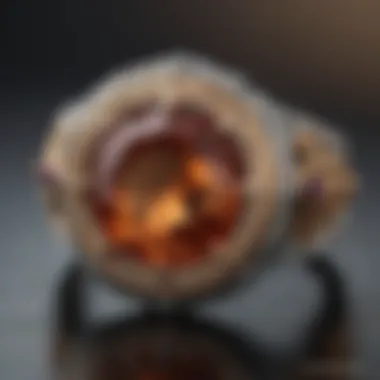

Customizing Ring Sizes: A Practical Approach
When it comes to rings, a perfect fit isn’t just about comfort; it’s about making a statement. Customizing ring sizes plays a vital role in achieving that ideal match, especially for gemstone enthusiasts and jewelry designers. Adjusting sizes can either enhance or detract from the beauty of a stone, so understanding the nuances involved is crucial.
A well-sized ring not only feels right but also highlights the stone’s brilliance and ensures longevity. In this section, we explore the different resizing procedures and the limitations that come with them, unveiling the intricacies of achieving that flawless fit.
Resizing Procedures
Resizing a ring can vary widely depending on its design, material, and the magnitude of the size change required. Here are some common procedures employed in the resizing process:
- Stretching:
This method involves carefully expanding the band to accommodate larger fingers. Stretching works well for simple metal bands without intricate designs or stones set too closely to the edge. - Cutting and Soldering:
For a substantial resize, a jeweler may cut the band and add a piece of metal to make it bigger or remove a section for a tighter fit. This method requires skill, as the ring must be meticulously soldered back together, ensuring it retains its original structure and design. - Using Adjusters:
A popular temporary solution, ring adjusters are soft, flexible bands that wrap around the ring's base to reduce its size. These are perfect for those who enjoy seasonal changes in finger size or for children whose fingers grow quickly.
"The right ring size can make a world of difference—not just for comfort, but for the appearance of the jewelry itself."
Each resizing method requires careful consideration. A skilled jeweler can provide insights into which approach will serve best based on the material and design.
Limitations of Resizing
Despite the benefits of resizing, it’s important to recognize that there are inherent limitations. These factors can affect not just the integrity of the ring, but also its long-term wearability and aesthetic appeal:
- Material Considerations:
Certain materials, like titanium or certain types of ceramic, can be difficult to resize. Once they’re made into a specific size, altering can lead to damage. - Stone Settings:
Rings with intricate stone settings may not be suitable for resizing without risking the stability of the stones. If a ring has a lot of decorative work or side stones, cutting and soldering can compromise structural integrity. - Diminished Value:
Resizing can potentially reduce the value of a ring. Collectors and enthusiasts often prefer pieces with all original features intact. An altered design or size can lead to diminished interest in the long run. - Depending on the type of resizing, it may affect the ring's overall design. Some rings may lose their distinct characteristics when resized.
In summary, while customizing ring sizes is a practical necessity for achieving the perfect fit, it comes with its own set of challenges. A conversation with a knowledgeable jeweler can provide the best insight tailored to individual needs, ensuring that the ring not only fits but continues to shine beautifully.
Epilogue: Ensuring Perfect Fit through Knowledge
In the world of gemstones and customized jewelry, understanding ring measurement charts is not just a niche interest but a necessity for enthusiasts, collectors, and designers alike. Knowledge is power, especially when it comes to the intricate details of ring sizing and the implications of errors in this arena. Getting the fit right does more than just enhance the wearer's comfort; it directly influences the overall aesthetics of the piece.
Each gemstone carries its own unique set of characteristics that can radically alter how a ring is perceived when worn. Sizing accurately with respect to these properties ensures that the beauty of each individual stone shines through. Without this insight, a beautiful ring could fall flat, both figuratively and literally, if it's too loose or too tight.
The significance of accurate sizing becomes even more pronounced when one considers the various charts available, whether they originate from the U.S., Europe, or the UK. Knowledge of these differing standards can save time and prevent frustrating mistakes—after all, in jewelry, as in life, a good fit is crucial. Additionally, recognizing how factors like temperature and personal body changes affect sizing can lead to decisions that reflect wisdom rather than guesswork.
Moreover, customizing ring sizes is not merely a reactive measure but can also be proactively addressed. Understanding the limitations and methods of resizing allows enthusiasts to approach any jewelry project with confidence, knowing that adjustments can be made when necessary without compromising the integrity of the piece.
"The right size is not merely about comfort; it’s a blend of artistry and science that speaks to the heart of jewelry crafting."
To encapsulate, the journey toward ensuring that rings fit perfectly is fortified by informed choices. Each chart, measurement method, and resizing technique discussed throughout this guide plays a critical role in achieving this goal. So, for gemstone aficionados and jewelry designers aiming for precision and artistry, the mantra should always be: invest time in learning, and let knowledge guide your pursuits.
In the end, it’s not just about rings; it’s about crafting experiences that blend the worlds of beauty and functionality.
- For further learning, check out Wikipedia and Britannica to expand your understanding of ring sizing and measurement charts.
Resources for Further Learning
The topic of ring measurement is vast and intricate, especially for gemstone enthusiasts and jewelry designers. It's vital to continue expanding knowledge beyond the basic understanding presented here. Accessing additional resources can illuminate various aspects of ring sizing and gemstone integration. The right resources can provide not only knowledge but also finesse in handling gemstones and designing jewelry that speaks to both technical precision and artistic vision.
Benefits of Further Learning
- Staying Updated: The world of jewelry making is always evolving. New techniques and tools emerge, and staying current can enhance skills and improve outcomes.
- Expanded Knowledge Base: Delving into more specialized materials can offer insights into niche topics, such as how different gemstone shapes influence ring design.
- Collaborative Opportunities: Engaging with online forums or communities fosters connections with other enthusiasts and professionals in the field. Learning from others’ experiences and insights is invaluable.
- Holistic Approach: Understanding related areas, like gemstone grading or even lapidary techniques, can significantly complement ring sizing expertise and lead to more informed decisions.
"Knowledge is not only power but also perspective. The more you know, the better choices you can make in jewelry design and gemstone selection."
Online Tools for Ring Measurement
In today's digital age, a plethora of online tools has emerged to aid in the ring measurement process. Some of these tools allow for an interactive experience, often offering visual representations that can significantly enhance understanding. Here are a few examples that can be particularly helpful:
- Ring Size Calculators: These tools let you input measurements or compare them against standard sizes to get a precise reading.
- Virtual Sizers: Some websites utilize augmented reality to help you visualize how different ring sizes would look on your hand, making it easier to make decisions.
- Printable Sizers: Most jewelry websites offer downloadable and printable ring size guides that can be used at home, saving the trouble of visiting a jeweler.
Familiarizing oneself with these tools can streamline the measuring process, allowing for more accuracy and reducing the chances of misjudgment.
Recommended Reading and Guides
Books, articles, and guides can provide a significant depth of knowledge. For those serious about exploring the multifaceted world of gemstone jewelry, consider diving into the following types of resources:
- Books on Gemology: Reading about gemstone types, qualities, and their symbolic meanings can deepen one’s appreciation and inform better designs. Titles like "Gemstones of the World" provide beautiful visuals along with valuable insights.
- Jewelry Design Manuals: Guides specifically focused on design principles can help craftsmen learn how to tailor rings for specific gemstones, such as how to adapt sizes based on the weight and setting of the stone.
- Online Courses and Webinars: Engaging in online learning platforms provides the guidance of seasoned professionals in the field and often includes hands-on projects to apply what you've learned.
Each of these resources can offer invaluable information that enhances both practical skills and theoretical understanding, making them essential for anyone aiming to excel in the gemstone and jewelry arena.






